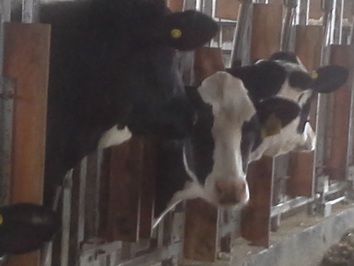A couple of weeks ago I went up to the University of New Hampshire to get an update on milk. A dietitian friend had arranged for a small group to meet with dairy scientist Dr. Peter Erickson. He shared some of the latest science behind milk production and took us on a tour of the dairy barns and milking operation. Here are some fun facts I learned about milk, cows and the dairy industry.
Today’s dairy cows produce over 150% more milk than in the past. This is because of selective breeding and attention to a clean comfortable farm environment and quality feed.
· The feed for the cows is not just meadow grass and hay. They eat a mixture of forage (chopped hay and/or corn) and nutritional pellets. The pellets are made from byproducts of human food production such as citrus pulp left over from making orange juice.
· BST (bovine somatotropin) can be given to cows to increase milk production, but it does not pass into the milk. Nonetheless, New England consumers have demanded milk from BST free cows. Farmers in the northeast participate in a regional agreement not to use BST.
· All milk is tested for the presence of antibiotics, and any contaminated milk is discarded. The tests are so sensitive that they can identify milk from just one “hot” cow in a tanker full of milk.
· The different fat levels of milk are created at the bottling plant. All the fat is skimmed off a tanker full of milk, and then added back to create the desired fat level.
· Holstein cows are the primary breed used for commercial milk. Guernsey cows, a less common breed, are smaller. Jersey cows, another smaller breed, produce milk with a high butterfat content. Because Guernsey and Jersey cows lack an enzyme to break down beta-carotene, cheeses made from their milk are more yellow than other cheeses.
Dr. Erickson says that the milk industry is on the cutting edge of efficient food production. He wants consumers to know that dairy farmers treat their cows well, saying, “The American farmer is primarily interested in producing a good quality food for the public.”
· The feed for the cows is not just meadow grass and hay. They eat a mixture of forage (chopped hay and/or corn) and nutritional pellets. The pellets are made from byproducts of human food production such as citrus pulp left over from making orange juice.
· BST (bovine somatotropin) can be given to cows to increase milk production, but it does not pass into the milk. Nonetheless, New England consumers have demanded milk from BST free cows. Farmers in the northeast participate in a regional agreement not to use BST.
· All milk is tested for the presence of antibiotics, and any contaminated milk is discarded. The tests are so sensitive that they can identify milk from just one “hot” cow in a tanker full of milk.
· The different fat levels of milk are created at the bottling plant. All the fat is skimmed off a tanker full of milk, and then added back to create the desired fat level.
· Holstein cows are the primary breed used for commercial milk. Guernsey cows, a less common breed, are smaller. Jersey cows, another smaller breed, produce milk with a high butterfat content. Because Guernsey and Jersey cows lack an enzyme to break down beta-carotene, cheeses made from their milk are more yellow than other cheeses.
Dr. Erickson says that the milk industry is on the cutting edge of efficient food production. He wants consumers to know that dairy farmers treat their cows well, saying, “The American farmer is primarily interested in producing a good quality food for the public.”
copyright 2015 Kathleen Searles, MS, RDN, CSSD, LDN

